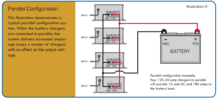I have two Iota DLS-90 switching power supplies that I connected together in parallel to get 180 amps for a straight 8 pill. I have noticed that the fans cycle on and off on only one of them. I currently only have a straight 4 pill connected to them. Is the fans running on only one unit because its not pulling enough amps to tax both of them? I currently have it wired with 8 gauge connecting the supplies and 4 gauge coming out of only one supply to my quick connect for amp. Is there something else that I need to do?
You are using an out of date browser. It may not display this or other websites correctly.
You should upgrade or use an alternative browser.
You should upgrade or use an alternative browser.
-
You can now help support WorldwideDX when you shop on Amazon at no additional cost to you! Simply follow this Shop on Amazon link first and a portion of any purchase is sent to WorldwideDX to help with site costs.
connecting two switching power supplies
- Thread starter 3strucking
- Start date
According to the manufacturer website, you can connect them either parallel or series. I did not see anything about using diodes.
Greg T
WDX-945 (Jazz Singer) Upper Peninsula of Michigan
I believe you need to be certain that both are set at the same voltage.
I believe you need to be certain that both are set at the same voltage.
And even that is tricky unless you use diode isolation or the supplies regulators are meant to operate in a master/slave configuration.
Greg T
WDX-945 (Jazz Singer) Upper Peninsula of Michigan
I've been using Megawatt PSUs for a long time. I've had a couple of their 36A models and those are not stackable. So now I use the model 700-12, 50A models and they are stackable as long as the voltages are matched. They're adjustable, but max out at 14.4V, whereas the smaller units max to a tad over 15V. I run my secondary radio off of a separate 50A megawatt, while my Texas Star DX-500V runs off of a pair of them. These are a bit more expensive than the amazon or Ebay supplies, but I have been inside of many different brands. Megawatt is the way to go.And even that is tricky unless you use diode isolation or the supplies regulators are meant to operate in a master/slave configuration.
I believe this is what he needs to read...
Excerpt from article above...

Aside from the "have to be equal in all aspects Cord length AWG and condition (stranded or solid - soldered lug or terminal)" which are requirements in any type of stacking supply mess, once all things are equal - then the issue of Fans kicking on and off might be from the differences - albeit slight - or the use of the IQ4 (Smart Charger) in one with a jumper is forcing one higher in output than the other - so they chase each other across the charging range in both current and voltage while under load. The one with the higher output in voltage - wins...
Excerpt from article above...

Aside from the "have to be equal in all aspects Cord length AWG and condition (stranded or solid - soldered lug or terminal)" which are requirements in any type of stacking supply mess, once all things are equal - then the issue of Fans kicking on and off might be from the differences - albeit slight - or the use of the IQ4 (Smart Charger) in one with a jumper is forcing one higher in output than the other - so they chase each other across the charging range in both current and voltage while under load. The one with the higher output in voltage - wins...
Attachments
BJ radionut
Supporting Member and 6m addict

A: Both set of leads Must be EQUALL in length and Size (ga)
B: Load connection at combiner point, must be sized to handle Total load.
https://www.cesco.com/resources/Ilsco/PBTD-2-3-0-M-F/Specification-Sheet.pdf
See: Amp rating greater than 170 amps/plus 3 connection blocks (2 in...1 Out)
Load wiring should be sized to handle total load and fused accordingly
This are where most fail to correctly install.
Use of these type amps requiring this type of power supply configuration, when done by proper NEC Codes is NUTS $$$$
Part 1: Choosing the Correct Wire Size for a DC Circuit - Blue Sea Systems
Engineering high quality marine electrical components for safety, reliability and performance
Above link DC wire size depending on load amps: Surprise!!!!
I just have to ask why I have seen two people now say that wire length connecting multiple power supplies would matter? It's DC and I have never seen that in any industrial applications that were high amperage DC. Maybe the shortest possible length to reduce cost and resistance but never for any other reason. Is there a reason? I asked an electrical engineer in the past year and they just laughed at me and said, it's DC and emphasized the "direct" part of the name. I said that's what I thought. Is there something I am missing?A: Both set of leads Must be EQUALL in length and Size (ga)
I used 2 Megawatt 36A paralleled together for long periods with no issues .... so I don't know what you're talking about.I've been using Megawatt PSUs for a long time. I've had a couple of their 36A models and those are not stackable. So now I use the model 700-12, 50A models and they are stackable as long as the voltages are matched. They're adjustable, but max out at 14.4V, whereas the smaller units max to a tad over 15V. I run my secondary radio off of a separate 50A megawatt, while my Texas Star DX-500V runs off of a pair of them. These are a bit more expensive than the amazon or Ebay supplies, but I have been inside of many different brands. Megawatt is the way to go.
I just have to ask why I have seen two people now say that wire length connecting multiple power supplies would matter? It's DC and I have never seen that in any industrial applications that were high amperage DC. Maybe the shortest possible length to reduce cost and resistance but never for any other reason. Is there a reason? I asked an electrical engineer in the past year and they just laughed at me and said, it's DC and emphasized the "direct" part of the name. I said that's what I thought. Is there something I am missing?
I think the reason they say all that is to ensure that the resistance is exactly the same between each supply and the load. The fact it is DC is really immaterial. As long as lead length is very close the difference in resistance is milliohms or less.
BJ radionut
Supporting Member and 6m addict
I'll explain this way.
DC circuits when running feeders: The total length of all current carrying conductors must be calculated.
Ex: This power supply hook-up
A: Power supply #1... has #4 ga wire 10 feet long to load (thus 20ft true length) @50 amps
Power supply #2 has #4 ga wire 3 feet (6 feet true length) @50 amps.
Thus, you have a Parrell DC circuit resistance.
You now have an imbalance of voltage drop across each load.
PS#1 equates to 5.1% voltage drop (12v in @load 11.4v)
PS#2 equates to 1.5% voltage drop (12v in @load 11.8v)
This is calculated at roughly room temperature (77 degs F) as the wire heats up due to current surges or usage, the resistance increases, thus the imbalance will increase.
This illustrates possible issues, if one was to use different size conductors on each supply.
EX : PS #1 #4 ga ... PS#2 #8 ga
Those voltage drops across each load becomes even more dramatic.
Having delt with these types of AC or DC circuits with Phasing AC Transformers / DC loads etc. for almost 30 years.
I call tell you it must be considered when building a system.
Even values this small, maintaining the equal balance across each load must be considered. IMHO
Consider this, 2 "phased" power supplies:
What happens to the current draw from each supply when you have a difference in voltage drop across the feeders?
One supply will have a HIGHER current draw than the other when suppling the load.
My worthless 2 cents
All the Best
Gary
DC circuits when running feeders: The total length of all current carrying conductors must be calculated.
Ex: This power supply hook-up
A: Power supply #1... has #4 ga wire 10 feet long to load (thus 20ft true length) @50 amps
Power supply #2 has #4 ga wire 3 feet (6 feet true length) @50 amps.
Thus, you have a Parrell DC circuit resistance.
You now have an imbalance of voltage drop across each load.
PS#1 equates to 5.1% voltage drop (12v in @load 11.4v)
PS#2 equates to 1.5% voltage drop (12v in @load 11.8v)
This is calculated at roughly room temperature (77 degs F) as the wire heats up due to current surges or usage, the resistance increases, thus the imbalance will increase.
This illustrates possible issues, if one was to use different size conductors on each supply.
EX : PS #1 #4 ga ... PS#2 #8 ga
Those voltage drops across each load becomes even more dramatic.
Having delt with these types of AC or DC circuits with Phasing AC Transformers / DC loads etc. for almost 30 years.
I call tell you it must be considered when building a system.
Even values this small, maintaining the equal balance across each load must be considered. IMHO
Consider this, 2 "phased" power supplies:
What happens to the current draw from each supply when you have a difference in voltage drop across the feeders?
One supply will have a HIGHER current draw than the other when suppling the load.
My worthless 2 cents
All the Best
Gary
dxChat
- No one is chatting at the moment.
-
-
-
@ BJ radionut:
Discord - A New Way to Chat with Friends & Communities
Discord is the easiest way to communicate over voice, video, and text. Chat, hang out, and stay close with your friends and communities.discord.com
-
-


